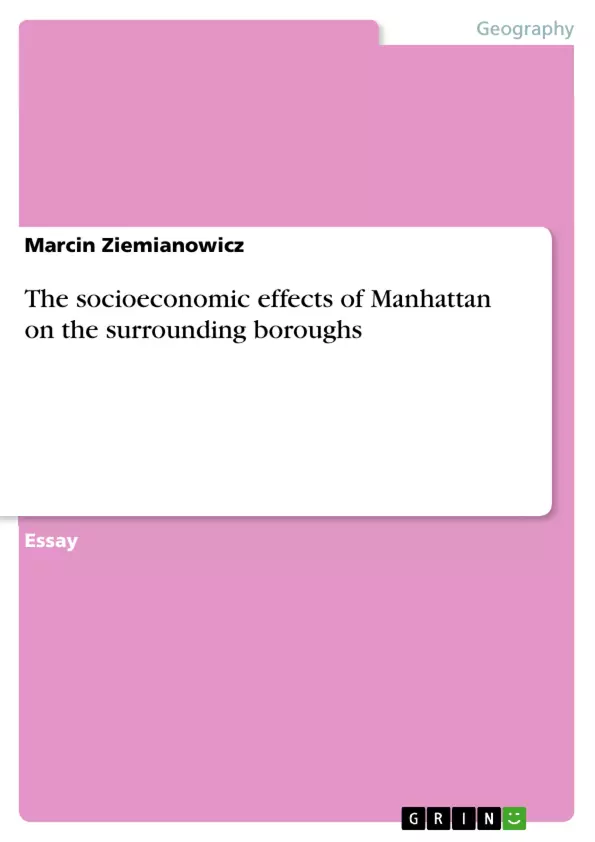New York had just under 20 million residents as of 20101, with nearly eight and a half million living in the city of New York City2, resulting in the largest city, population wise, in all of the United States. Manhattan has only one and a half million residents, yet it has multi-billion dollar buildings, the location of the two largest stock exchanges, NASDAQ and NYSE, and one of the best mass transit systems in America. Looking a bit to the east across the East River are the five boroughs of New York City, lacking any skyscrapers, or the subway which Manhattan has and substituting it with an elaborate bus system, and not even a single national landmark on the same scale as Grand Central. The question is, how has this small yet extremely influential island changed the area around it, and if it has been for the better or worse.
Inhaltsverzeichnis (Table of Contents)
- Introduction
- The Rise of Manhattan
- Early Colonization and Strategic Location
- Growth Fueled by Immigration and Economic Activity
- Geological Advantage and Land Value
- The Stagnant Status of Other Boroughs
- Lack of Economic Incentive and Infrastructure
- The Chicken and Egg Problem
- Benefits of Manhattan's Uneven Development
- Improved Transportation and Infrastructure
- Addressing the Uneven Development
- Incentives for Development
- Requirements for Development
- Strategies for Enhancing Other Boroughs
Zielsetzung und Themenschwerpunkte (Objectives and Key Themes)
This text aims to analyze the reasons behind the uneven development of Manhattan compared to the other boroughs of New York City. It explores the factors that have contributed to Manhattan's rise as a major economic and cultural hub, while the other boroughs have remained primarily residential. * **Uneven Development:** The text examines the stark difference in economic growth and infrastructure between Manhattan and the other boroughs. * **Geographic Location and Geology:** The text highlights the strategic location and geological composition of Manhattan, which have contributed to its development. * **Economic Incentive and Infrastructure:** The text explores the lack of economic incentives and suitable infrastructure for development in the other boroughs. * **Benefits of Uneven Development:** The text acknowledges the positive impact of Manhattan's development on the surrounding boroughs, such as improvements in transportation and infrastructure. * **Strategies for Balanced Growth:** The text proposes strategies for stimulating development in the other boroughs, including incentivizing businesses and improving infrastructure.Zusammenfassung der Kapitel (Chapter Summaries)
The first chapter introduces the stark contrast between Manhattan and the other boroughs of New York City. It discusses the high concentration of wealth and power in Manhattan, and the lack of skyscrapers and significant landmarks in the other boroughs. The second chapter explores the historical and geographical factors that have shaped Manhattan's growth. It traces the city's origins to the strategic location of Fort Amsterdam and its subsequent development fueled by immigration and economic activity. The chapter emphasizes the importance of Manhattan's geological composition, specifically its bedrock, which makes it ideal for construction of large buildings. The third chapter focuses on the reasons behind the stagnant status of the other boroughs. It highlights the lack of economic incentives and the chicken and egg problem regarding infrastructure and development. The fourth chapter discusses the benefits of uneven development, particularly the positive impact of Manhattan's growth on the surrounding boroughs through improved transportation and infrastructure. The fifth chapter addresses the issue of uneven development and suggests strategies for stimulating growth in the other boroughs. It emphasizes the importance of incentives, infrastructure improvements, and enhancing the quality of life in these areas.Schlüsselwörter (Keywords)
The text focuses on key terms like uneven development, economic growth, geographic location, geological composition, infrastructure, economic incentives, and strategies for balanced growth. It examines these concepts in the context of the development of Manhattan and the other boroughs of New York City.- Quote paper
- Marcin Ziemianowicz (Author), 2012, The socioeconomic effects of Manhattan on the surrounding boroughs, Munich, GRIN Verlag, https://www.grin.com/document/210765



